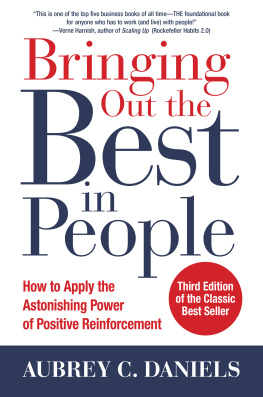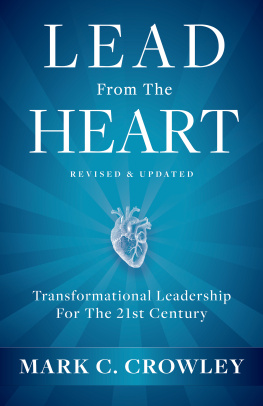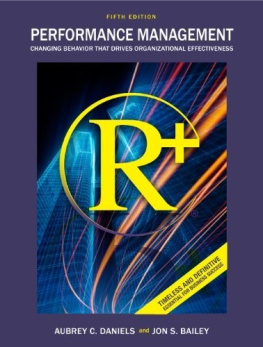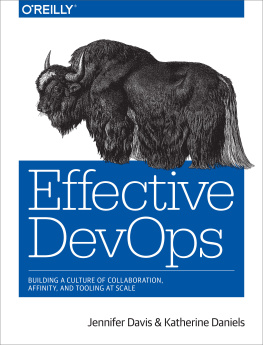Contents
Guide

Copyright 2016 by Aubrey Daniels International. All rights reserved. Printed in the United States of America. Except as permitted under the United States Copyright Act of 1976, no part of this publication may be reproduced or distributed in any form or by any means, or stored in a database or retrieval system, without the prior written permission of the publisher.
1 2 3 4 5 6 7 8 9 0 DOC 21 20 19 18 17 16
ISBN 978-1-259-64490-0
MHID 1-259-64490-1
e-ISBN 978-1-259-64489-8
e-MHID 1-259-64489-4
McGraw-Hill Education books are available at special quantity discounts to use as premiums and sales promotions or for use in corporate training programs. To contact a representative, please e-mail us at bulksales@mheducation.com.
This book is dedicated to my mother,
Carrie Belle Daniels (19132016),
who always brought out the best in me.
Contents
PART 1
The Perils of Traditional Management
PART 2
The Astonishing Power of Positive Reinforcement
PART 3
The Scientific Approach to Leadership
PART 4
Turning Good Intentions into High Performance
Preface
Much has changed since 1994 when this book was first writtenthe iPod, iPad, Skype, GPS, mobile broadband, YouTube, Bluetooth, iPhone, Facebook, Twitter, Pinterest, Instagram, search engines, smartphones, Amazon, satellite TV, and Wikipedia, to name a few. Access to information is now at everyones fingertips. An endless amount and variety of videos, books, and articles are virtually free to anyone who owns a computer, tablet, or smartphone. Ways of communicating with people around the globe are just a few keystrokes away. In many ways the world has been revolutionized in the last 22 years.
Someone found in the jungle after being given up for dead for 20 years would find it difficult to get in the door of the average business and would be completely lost when shown his former workspace. He would not know how to turn on a computer, much less how to use it. However, when he went to Human Resources (HR), he would be right at home because HR policies are pretty much the same. Although he would be pleased with the current salary or hourly wage, the structure of the organization, policies about how to behave, and the consequences of failure to conform will have changed little.
In the first chapter of the second edition of this book, I stated that many of the current theories of management and leadership were wrong. In the intervening 16+ years, not much has happened to change my opinion. They are still wrong. And all the books, articles, and management seminars of the last two decades have done little to affect the form and practice of management.
Something else that has not changed is the laws of behavior. Behavior changes today just like it did 20 years ago. Make that more than 2,000 years ago. As far as we can tell, behavior wont change for another 2,000 years from now. We learned from our environment 2,000 years ago, and we still do. The problem is that only a very few of those who designed business environments knew the laws of behavior then and now.
This is a long way of saying that even though much has changed since 1994, much of what I wrote in the first edition is still in the third edition. In this edition, I have tried to update examples and have added three new chapters. One chapter is about technology and how it is changing behaviorsometimes for the betterand how sometimes it is creating new problems. Another chapter is about engagement because it is still a major issue in the supercompetitive business climate we find ourselves in as we enter the twenty-first century, even though businesses have been working on this for over 100 years.
Also, the examples have been updated because some of them in the first edition are unknown to many who are currently entering the workforce. Some references also have been added. The basic concepts of the science are still the same. Hopefully, some of the edits I have made will make these concepts easier to understand and apply.
In my 45 years of teaching executives, managers, supervisors, and employees the science of behaviorbehavior analysisI have often heard it referred to as a soft science. The implication is that it is not really a science at all. Physics, biology, and chemistry are often called hard sciences. In my opinion, all real science is hard science. Experimenters either follow the scientific method so that their findings can be replicated or they dont. I believe that a well-designed experiment never has a bad outcome. Even negative results add to the body of knowledge because that relationship between variables need not take time away from other important experimentation.
What is required for a finding to be scientific is not well understood, even by many academics. Many in fields of study like to think that the content they teach is not learned from random experience but from carefully constructed scientific studies. However, much of the content fails the acid tests of scienceprediction and control. Sir Peter Medawar, writing on the limits of science in 1984, said, I expect that its embarrassing infirmity of prediction has been the most important single factor that denies the coveted designation of science to, for example, economics. There are more theories of behavior in psychology than there are psychologists because every psychologist has more than one.
In my blog (www.aubreydanielsblog.com) and presentations I encourage participants to look at a study to see the variables under study, how they were tested and evaluated, and the conclusions the authors draw from the data before they take something presented as scientifically demonstrated. It is not uncommon that a study is well designed, but the data do not support the interpretation.
In this book I will try to present what the research has discovered over the last 80 years or soand do so in a way and with words that are easily understood so that it can be put into practical use. I will also try to clearly separate what science knows from what is my opinion.
Let me end with a quote from Robert Owen, written in 1813:
If, then, due care as to the state of your inanimate machines can produce such beneficial results, what may not be expected if you devote equal attention to your vital machines, which are far more wonderfully constructed?
When you shall acquire a right knowledge of these, of their curious mechanism, of their self-adjusting powers; when the proper mainspring shall be applied to their varied movements you will become conscious of their real value, and you will readily be induced to turn your thoughts more frequently from your inanimate to your living machines; you will discover that the latter may be easily trained and directed to procure a large increase of pecuniary gain, while you may also derive from them high and substantial gratification.
What I intend to present in this book is a right knowledge of human behavior as we know it today so that businesses can realize the benefits described by Robert Owen over 200 years ago.
Note
. Robert Owen, A New View of Society (1813).
PART
The Perils of Traditional Management
1
Fads, Fantasies, and Fixes
What if you lived in the 1980s, saved your money, moved into your dream house in an isolated wooded area with a great view, bought a new car, and everything seemed to be going your way, and then you woke up one morning and noticed that even though you went to bed early, you were still tired and had low energy. You began to feel sleepy and could fall asleep anywhere. When you told a friend about it, she asked if you had been tested for sleep apnea. You scheduled an appointment with a doctor, were tested, and the results came back negative. The doctor suggested that you might try to sleep on your side and raise the head of the bed slightly for a better rest. You tried what the doctor recommended, but after an initial improvement for several weeks, you realized that you were no better. After several months of continued tiredness and low energy, a return to the doctor resulted in a test for low testosterone. When the results came back, it was marginally low but within the normal range, but your doctor, on the side of caution, recommended using a low dosage of testosterone in the form of a patch. For several months you felt better, but after a while, you began to notice some side effects and realized that the initial symptoms were unchanged. At your annual physical, when you reported your continued problems, your doctor suggested that you should take a multivitamin with iron. The results were the same as the others: short-term benefit that soon gave way to the same tired, low-energy feelings. After many trips to the doctor with the same effect, you found yourself trying supplements you saw advertised on TV or the Internet. After hundreds of dollars and many years of trying, you gave up and decided that this was just something you had to live with. Suddenly, it seems, it is the year 2020. You meet a new employee at work, and she asks where you live. You tell her your address, and she says it certainly is a beautiful area and she considered a house in that area until after considerable research she discovered that it was the site of a factory that made chemicals during World War II. Because it had been so many years, the records were sketchy and long forgotten. To make a long story shorter, tests revealed that toxic fumes were still present and were the cause of the problems you had been experiencing all those years. Nothing was wrong with youyou were responding naturally to the environment in which you found yourself.
















